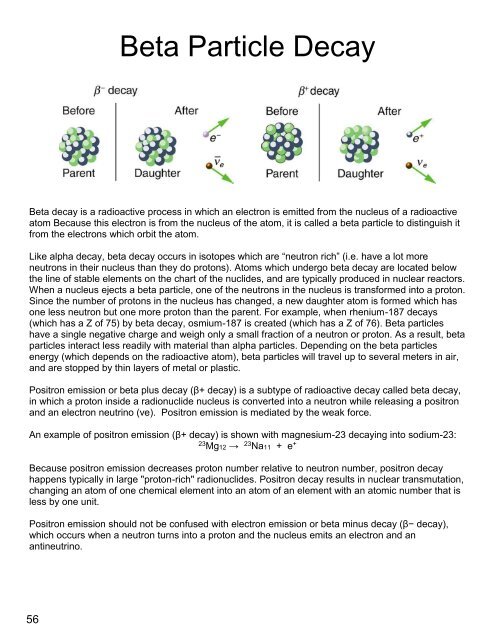You also want an ePaper? Increase the reach of your titles
YUMPU automatically turns print PDFs into web optimized ePapers that Google loves.
Beta Particle Decay<br />
Beta decay is a radioactive process in which an electron is emitted from the nucleus of a radioactive<br />
atom Because this electron is from the nucleus of the atom, it is called a beta particle to distinguish it<br />
from the electrons which orbit the atom.<br />
Like alpha decay, beta decay occurs in isotopes which are “neutron rich” (i.e. have a lot more<br />
neutrons in their nucleus than they do protons). Atoms which undergo beta decay are located below<br />
the line of stable elements on the chart of the nuclides, and are typically produced in nuclear reactors.<br />
When a nucleus ejects a beta particle, one of the neutrons in the nucleus is transformed into a proton.<br />
Since the number of protons in the nucleus has changed, a new daughter atom is formed which has<br />
one less neutron but one more proton than the parent. For example, when rhenium-187 decays<br />
(which has a Z of 75) by beta decay, osmium-187 is created (which has a Z of 76). Beta particles<br />
have a single negative charge and weigh only a small fraction of a neutron or proton. As a result, beta<br />
particles interact less readily with material than alpha particles. Depending on the beta particles<br />
energy (which depends on the radioactive atom), beta particles will travel up to several meters in air,<br />
and are stopped by thin layers of metal or plastic.<br />
Positron emission or beta plus decay (β+ decay) is a subtype of radioactive decay called beta decay,<br />
in which a proton inside a radionuclide nucleus is converted into a neutron while releasing a positron<br />
and an electron neutrino (νe). Positron emission is mediated by the weak force.<br />
An example of positron emission (β+ decay) is shown with magnesium-23 decaying into sodium-23:<br />
23 Mg12 → 23 Na11 + e +<br />
Because positron emission decreases proton number relative to neutron number, positron decay<br />
happens typically in large "proton-rich" radionuclides. Positron decay results in nuclear transmutation,<br />
changing an atom of one chemical element into an atom of an element with an atomic number that is<br />
less by one unit.<br />
Positron emission should not be confused with electron emission or beta minus decay (β− decay),<br />
which occurs when a neutron turns into a proton and the nucleus emits an electron and an<br />
antineutrino.




